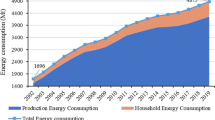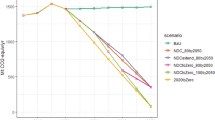Abstract
The RoSE (Roadmaps to Sustainable Energy Futures) project provides a coordinated, model-based analysis to manage the transition from carbon intensive to low carbon economies using several global integrated assessment models to explore different GHG stabilization scenarios. China TIMES provides a detailed description of the Chinese energy system that can be used to check the realism of transition scenarios for China against global models. A reference scenario with China’s target of lowering its carbon intensity by 40–45 % by 2020 compared to the 2005 level is considered, and 12 carbon constraint scenarios with different levels of carbon intensity reduction beyond 2020 are simulated by China TIMES. The results of carbon emissions pathways and energy system transitions in different scenarios are analyzed. The results from China TIMES are compared to those for both the reference and carbon policy scenarios (550 ppm CO2eq and 450 ppm CO2eq stabilization targets) for four global models, GCAM, IPAC, REMIND, and WITCH. The differences in decarbonizaton pathways across models are mainly attributed to different model structures and modeling approaches, different reference scenario definitions, different policy targets, differences in model assumptions concerning technology availability and techno-economic characteristics of the technologies, and differences in the estimation of the energy demand response to climate policy. The path towards low carbon development for China includes challenges and opportunities. Substantial efforts may be required to transform the economic development mode, to speed up innovation, R&D, and deployment of advanced low carbon technologies, to strengthen institutions, to advocate low carbon lifestyles, and to enhance international cooperation.








Similar content being viewed by others
References
Bosetti, V., E. Massetti, et al., 2007. The WITCH Model. Structure, Baseline, Solutions. Climate Change and Sustainable Development.
Chen W (2005) The costs of mitigating carbon emissions in China: findings from China MARKAL-MACRO modeling. Energy Policy 33(7):885–896
Chen, W., 2011. China MARKAL/TIMES Documentation. ROSE project report.
Chen W, Wu Z (2004) Current status, challenges, and future sustainable development strategies for China energy. Tsinghua Science & Technology 9(4):460–467
Chen W, Wu Z et al (2007) Carbon emission control strategies for China: A comparative study with partial and general equilibrium versions of the China MARKAL model. Energy 32(1):59–72
Chen W, Li H et al (2010) Western China energy development and west to east energy transfer: application of the Western China Sustainable Energy Development Model. Energy Policy 38:7106–7120
Chen W et al (2012) Climate Change Impact, Adapation and Mitigation in China. Tsinghua University Press, Beijing
China renewable energy development strategy research team (CREDSRT) (2008) China Renewable Rnergy Development Strategy. China electricity power press, Beijing
Clarke L, Lurz J et al (2007) Model Documentation for the MiniCAM Climate Change Science Program Stabilization Scenarios: CCSP Product 2.1a. Pacific Northwest National Laboratory, Washington
Haller, M., 2012. CO2 mitigation and power systen integration of fluctuating renewable energy sources: A multi-scale modeling approach, von der Fakultät VI – Planen Bauen Umwelt. der Technischen Universität Berlin
Jiang K, Liu Q, Zhuang X, Hu X (2010) Technology roadmap for low-carbon society in China. Journal of Renewable Sustainable Energy 2(3):109–120
Leimbach M, Bauer N et al (2010) Mitigation costs in a globalized world: Climate policy analysis with REMIND-R. Environment Model Assess 15:155–173
Loulou, R., U. Remne, et al., 2005. Documentation for the TIMES Model, PART I: Energy Technology Systems Analysis Programme, http://www.etsap.org/tools.htm
Luderer G, Pietzcker R, Kriegler E, Haller M, Bauer N (2012) Asia's role in mitigating climate change: A technology and sector specific analysis with ReMIND-R. Energy Economics 34:5378–5390
Pacala S, Socolow R (Stabilization Wedges: Solving the climate problem for the next 50 years with current technologies) Stabilization Wedges: Solving the climate problem for the next 50 years with current technologies. Science 305:968–972
Rogner, H.-H., R. F. Aguilera, R. Bertani, S. C. Bhattacharya, M. B. Dusseault, L. Gagnon, H. Haberl, M. Hoogwijk, A. Johnson, M. L. Rogner, H. Wagner and V. Yakushev, 2012: Chapter 7 - Energy Resources and Potentials. In Global Energy Assessment - Toward a Sustainable Future, Cambridge University Press, Cambridge, UK and New York, NY, USA and the International Institute for Applied Systems Analysis, Laxenburg, Austria.
Acknowledgments
We would like to thank the Ministry of Science and Technology of China for the support to develop China TIMES model (2012BAC20B01), and Stiftung Mercator and Potsdam Institute for Climate Impact Research for the support on scenario runs and model comparisons. And we also would like to thank Elmar Kriegler, Ioanna Mouratiadou, Katherine Calvin, Enrica Decian, Kejun Jiang and anonymous reviewers for their valuable comments on the paper.
Author information
Authors and Affiliations
Corresponding author
Additional information
This article is part of a Special Issue on "The Impact of Economic Growth and Fossil Fuel Availability on Climate Protection" with Guest Editors Elmar Kriegler, Ottmar Edenhofer, Ioanna Mouratiadou, Gunnar Luderer, and Jae Edmonds.
Rights and permissions
About this article
Cite this article
Chen, W., Yin, X. & Zhang, H. Towards low carbon development in China: a comparison of national and global models. Climatic Change 136, 95–108 (2016). https://doi.org/10.1007/s10584-013-0937-7
Received:
Accepted:
Published:
Issue Date:
DOI: https://doi.org/10.1007/s10584-013-0937-7




